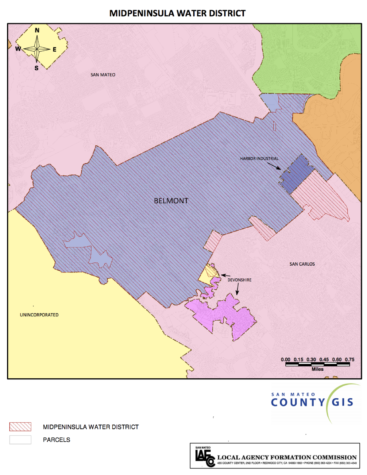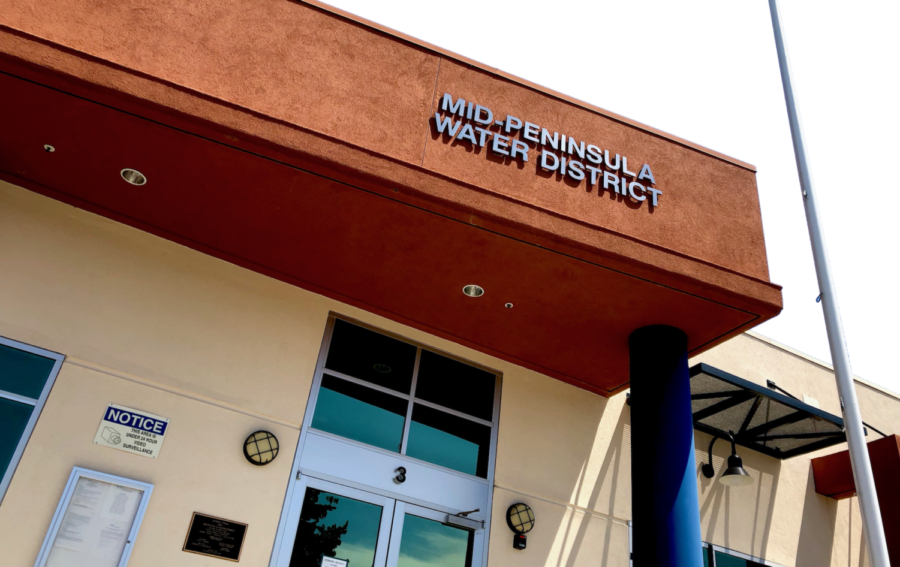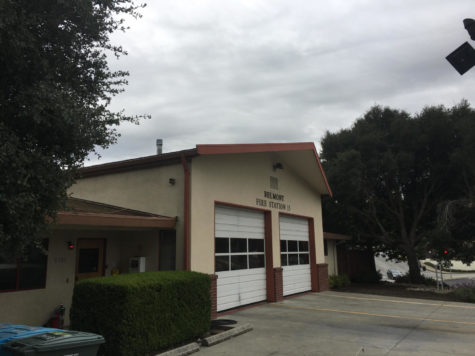Cut the check, get the service.
This is the modus operandi of public and private utilities everywhere. So long as the money ends up in the right hands, the water keeps flowing and the lights stay on.
If you live in Belmont, the check for the water bill ends up in the hands of the Mid-Peninsula Water District, a public agency headquartered at 3 Dairy Lane just next to US-101. They in turn purchase and pipe water originally from the Hetch Hetchy reservoir in Yosemite National Park, through the San Francisco Regional Water System, to the homes of Belmont residents as well as those living in small portions of San Carlos, Redwood City, and unincorporated San Mateo County.
The Water District is a local government. It has a board of directors, an appointed general manager, and staff. This all sounds a lot like Belmont’s city government, which is, on a broad level, also composed of those same core elements: it has a governing city council, an appointed city manager, and several departments which are populated by staff.
But the Water District and the City of Belmont, despite both servicing city infrastructure and sharing a nearly indistinguishable boundary, are completely separate entities.

A map showing the jurisdiction of the Water District relative to city limits.
The Water District is a special district. Special districts, unlike departments of the city government or the city government as a whole, are independent, mostly-autonomous organizations charged with maintaining one or more essential utilities or services. They have independent bureaucracies, in most cases elected governing boards, and are funded by taxpayers and ratepayers. According to their website, MPWD was formed as the “Belmont County Water District” in 1929 when seven former sanitary agencies consolidated. And as the city grew over the years, the Water District grew to accommodate it.
Today, the City and the Water District, each with a separate administrative bureaucracy, share a jurisdiction that is nearly identical. Matt Zucca, who has sat on the Board of Directors of the Water District since he was appointed to fill a vacancy in 2005, estimates that, excluding the Harbor Industrial Area, only 5 percent of the district’s customers lie outside of city limits.
“Ours is really a function of the history behind the aggregation of the six Water Districts,” Zucca said of their jurisdiction.
But given the single-service nature of the Water District, some think that perhaps the time has come to consider alternatives. Douglas Kim, who is currently the mayor of Belmont and has served on the City Council since 2015, is one such person.
“When you’re looking at a special district that, for all intents and purposes, mimics our city boundaries, I think I have the same kind of questions a lot of people do about whether or not that governance structure is the right one to plan, operate, maintain, and deliver our water to the people of Belmont,” Kim said.
Zucca agrees that all decisions should be informed by what would best serve the ratepayers, and that further study should be undertaken to advise the best path forward based on overall benefit to the customer. But he also notes that the City of Belmont is currently responsible for the city’s sewer and storm drain infrastructure, both of which, he says, the district could be better equipped to maintain.
“I would argue that we ought to equally study if it’s cost-effective to have us take over utilities,” Zucca said. “If you’re going to study, you have to study the flip-side: would it make sense for us to take over sanitary and storm?”
Furthermore, Zucca emphasizes the benefits of having an agency of specialists operate the city’s water supply, a utility of which he believes proper management is critical. Many members of the Water District’s board of directors have long backgrounds in public and private utilities — credentials which enable them, says Zucca, to make decisions regarding water policy not affected by the politics that might influence similar votes of the city council.
Oversight and accountability
San Mateo County’s Local Agencies Formation Commission, or LAFCo, is a county agency charged with “jurisdiction over changes in organization and boundaries of cities and special districts including annexations, detachments, incorporations and formations,” according to their website. They routinely produce reports called municipal service reviews to “attempt to capture and analyze information about the governance structures and efficiencies of service providers, and to identify opportunities for greater coordination and cooperation between providers,” according to the California Association of Local Agency Formation Commissions.
Another fundamental problem that I think is wrong with [the LAFCo report] is that it justifies efficiency and the intellectual concept of efficiency, and then when it brings data to bear about efficiency, there was no data [to substantiate the recommendation].”
— Matthew Zucca, Mid-Peninsula Water District Board of Directors
In January, 2011, LAFCo produced a municipal service review of the Water District analyzing the solvency and future of the agency. The report was ultimately submitted with the primary recommendation “that the district be established as [a] subsidiary district of the City of Belmont.”
Making the Water District a subsidiary district of the City would likely lead to staff consolidations and would eliminate the District’s Board of Directors, which would become the City Council.
That recommendation was made before a November 2011 scandal in which a former employee of the Water District, who was in charge of managing the agency’s finances, was found to have embezzled a substantial quantity of money — $248,000 over a three year period, according to the SF Examiner — after she suffered a stroke and fiscal improprieties were discovered by the employee who took over her duties.
“In this particular case, the investigator said it was incredibly creative. They’d never seen anything this sophisticated,” Zucca said, who was president of the board at the time of the scandal. “During an audit, her system allowed her to avoid the random scrutiny of records from the third-party auditing team.”
Still, that scandal had widespread ramifications for the district, which received intense media scrutiny and faced questions concerning oversight and accountability.
Kim said, “I think there needs to be better accountability from my standpoint.”
Tammy Rudock, who has served as the general manager of the Water District since 2012, was appointed in the wake of the embezzlement scandal. She says that levels of transparency and accountability have never been higher.
“We want to be as transparent as possible to the people who matter the most, the people who own the infrastructure: the ratepayers,” Rudock said. “I dare anyone to claim that we don’t send them enough information.”
In the wake of a similar scandal in which the former finance director of the San Mateo County Mosquito and Vector Control District was found guilty of embezzling $450,000 from agency coffers, the San Mateo County Grand Jury produced a report entitled, “Who is really in charge of the taxpayer’s money?” It makes a slew of recommendations concerning the management of special districts, many of which have to do with specific deficiencies present in the Mosquito District at the time of the scandal.
However, it takes care to note that the Water District is an example of an agency in which “the underlying problems, inadequate controls and oversight, are the same.”
But Zucca, who said that he has faith in the Water District’s renewed ability to execute checks and balances after fundamental changes in the organization were made following the embezzlement scandal, is also skeptical of the LAFCo report.
“Another fundamental problem that I think is wrong with [the LAFCo report] is that it justifies efficiency and the intellectual concept of efficiency, and then when it brings data to bear about efficiency, there was no data [to substantiate the recommendation],” Zucca said.
This is in keeping with the report, which states that “fiscal analysis of establishing a subsidiary district is beyond the scope of a municipal service review.”
Kim, whose experience in public service includes a 30-year stint as an urban planner in Los Angeles before moving to Belmont, has concerns regarding whether the existence of two separate bureaucracies operating within the same city limits and serving the same population is still the most efficient option.
“It does seem reasonable, given that they’re coming upon their hundredth anniversary, to revisit how we deliver water to the good people of Belmont,” Kim said. “I think every century it’s reasonable to revisit the purpose of any public agency.”
It does seem reasonable, given that they’re coming upon their hundredth anniversary, to revisit how we deliver water to the good people of Belmont. I think every century it’s reasonable to revisit the purpose of any public agency.
— Belmont Mayor Douglas Kim
Zucca stresses that his view of consolidation is based on overall benefit to the ratepayers, and that alternative options should be explored if evidence is introduced demonstrating a tangible reduction in costs for district customers.
“My job is to represent the residents of Belmont to the best of my ability. I’m not here to defend the existence of the water district,” Zucca said. “So far, no-one has come even close to demonstrating how [district consolidation] would be a benefit.”
Similarly, Kim thinks the best way to accomplish this is through an investigation of the agency’s operations, by which decisions regarding consolidation or changes in governance could be informed.
“When you look at the administrative costs for the Water District, it’s easy to think that maybe they’re out of proportion with the charge of the agency, so I think a performance audit might be able to confirm whether or not there are better ways to control costs while maintaining or even improving the quality of water for our city,” Kim said.
Karl Mittelstadt, who worked for the Belmont Parks and Recreation Department for 40-years until his retirement as Director in 2005, was an employee of the city the last time consolidation was considered in the 1990s. Although the potential was debated, the issue was never formally reviewed. It does not appear any proposals to merge the agencies were made public.
“There were, and I don’t know when this was — could have been in the 80s or early 90s — discussions of the city merging with the district and the district merging with the city and becoming a department of the city,” Mittelstadt said. “It was personalities. I don’t know if it was over any type of specific issue. It was more political than anything else.”
Any consolidation has the potential to carry with it deep institutional changes. If the Water District were to be consolidated with the city and made a subsidiary, the Board of Directors would be made obsolete, as might certain members of the staff, some of whose jobs could be taken over by existing members of the city bureaucracy.
“You’ve got people, you’ve got areas of responsibility, you’ve got fiefdoms. There’s a lot of psychology that goes into this that I can’t even pretend to dissect,” Zucca said. “There’s individual motivations, political motivations, whatever the case might be.”
And, Mittelstadt said, “if it were to happen, you’d have to approach this from a dollars-and-cents [perspective]. Is it going to save the taxpayers or the ratepayers money?”
Regional partnership
Even if the agency’s necessity as an independent governmental unit is up for debate, the first and foremost duty of the Water District is, indisputably, to provide paying Belmont residents and entities access to water.
To that end, Mittelstadt said that during his tenure, he had no complaints.
“As director of Parks and Recreation, and previously to that Parks Superintendent, we were a major water user in Belmont, with all the parks and athletic fields,” Mittelstadt said. “The relationship was fine. They delivered water; we never had a problem with service; if there was an issue we would call and get a good response.”
Mittelstadt cites an example as evidence of their willingness to partner with the city on matters of local relevance. In the 1970s, California underwent a severe drought that forced municipalities everywhere to make cutbacks to their water consumption.
Mittelstadt said, “They were good enough to work with us to, instead of having each site cut back 50 percent, [look at the Parks Department] as one massive account so that we could cut back 100 percent here, and have more water elsewhere.”
Today, Rudock, whose tenure has overseen several joint projects with the city, notes three examples of areas in which the water district has been engaged in cooperation with the city at a staff level: North and Davey Glen Roads, Francis Avenue and Court, and Academy Avenue and Belburn Drive.
“One of the goals and objectives of the Board of Directors in the strategic planning process is just to coordinate better and to build a better relationship, because there was maybe not as collaborative of one in the past,” Rudock said. “We meet primarily on a staff level with the public works department to coordinate projects and ensure that we’re offering the ratepayers the best and most cost-effective [options].”
Like Mittelstadt and Rudock, Zucca believes the organizations are successful in coordinating at a staff level. He also noted that the relationship has improved in recent years with the execution of more joint projects between the two entities.
Afshin Oskoui, the Director of Public Works for the City of Belmont, agrees that the relationship between agency staff is cooperative and successful.
“From my perspective, we have been working very collaboratively with the Water District staff,” Oskoui said. “We hold regular quarterly meetings to go over projects, and issues as it relates to our areas of operation.”
However, says Zucca, at an elected level, the relationship leaves room for improvement. He alleges the city has rebuffed attempts by the district board of directors to organize joint meetings.
“Historically, we have had significant difficulties setting up what used to be annual meetings between City and District elected and staff leadership to the point where we stopped trying to schedule the meetings,” Zucca said. “More recently, we requested a subcommittee meeting to discuss coordinating infrastructure and were told the meeting was not necessary and cooperation should be managed at the staff level.” (Sources in city staff and on the city council, when asked about this allegation, declined to comment.)
In view of this alleged discord, Zucca believes that it is time to reconsider the need to push for better cooperation between the two entities.
“I will bring up at the next board meeting that we should reinvigorate the effort to meet with a subcommittee of the city council and talk about cooperation,” Zucca said.
















Sachin Deshpande • Oct 14, 2018 at 2:17 pm
This was a terrific article that explained all perspectives (city, water special district, and independent city council) so well! Keep up the great work.